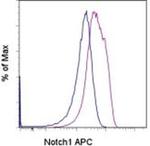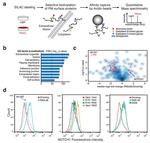Search Thermo Fisher Scientific
Invitrogen
NOTCH1 Monoclonal Antibody (MHN1-519), APC, eBioscience™
FIGURE: 1 / 2
NOTCH1 Antibody (17-9889-42) in Flow


Product Details
17-9889-42
Species Reactivity
Published species
Host/Isotype
Recommended Isotype Control
Class
Type
Clone
Conjugate
Excitation/Emission Max
Form
Concentration
Purification
Storage buffer
Contains
Storage conditions
Shipping conditions
RRID
Product Specific Information
Description: This MHN1-519 monoclonal antibody reacts with human Notch1, one of four members of the Notch family of receptors. Notch receptors are 300-kDa single-pass transmembrane proteins. While the extracellular domain contains numerous epidermal growth factor-like repeats for ligand binding, the intracellular domain is involved in cell signaling. Upon binding its membrane-bound ligand (either Delta or Jagged), the Notch receptor undergoes proteolytic cleavage, first by ADAM-family metalloproteases and then by gamma-secretase. The second cleavage event releases the Notch intracellular domain (NICD), which subsequently translocates into the nucleus, heterodimerizes with the DNA-binding protein RBP-J, recruits co-activator molecules, and ultimately activates transcription.
Notch 1 is expressed on thymocytes, bone marrow hematopoietic stem cells, T and NK cells. Lower Notch1 expression levels can be found on B cells and monocytes. Studies show that some subsets of T-cell acute lymphoblastic leukemia (T-ALL) arise due to Notch1 chromosomal translocation with the TCRbeta gene, which results in the expression of constitutively active Notch1. This cell surface receptor is involved in T cell lineage commitment, thymocyte development, and Th2 differentiation.
The MHN1-519 monoclonal antibody recognizes the extracellular domain of Notch1, and has also been reported to block Notch1 binding to Delta-like 4.
Applications Reported: This MHN1-519 antibody has been reported for use in flow cytometric analysis.
Applications Tested: This MHN1-519 antibody has been pre-titrated and tested by flow cytometric analysis of normal peripheral blood cells. This can be used at 5 µL (0.25 µg) per test. A test is defined as the amount (µg) of antibody that will stain a cell sample in a final volume of 100 µL. Cell number should be determined empirically but can range from 10^5 to 10^8 cells/test.
Excitation: 633-647 nm; Emission: 660 nm; Laser: Red Laser.
Filtration: 0.2 µm post-manufacturing filtered.
Target Information
The notch gene belongs to a family of epidermal growth factor (EGF) like homeotic genes, which encode transmembrane proteins with a variable number of cysteine-rich EGF-like repeats in the extracellular region. Four notch genes have been described in mammals: Notch1, Notch2, Notch3 and Notch4(Int-3), which have been implicated in the differentiation of the nervous system and other structures. The EGF-like proteins Delta and Serrate have been identified as ligands of Notch1. Mature Notch proteins are heterodimeric receptors derived from the cleavage of Notch pre-proteins into an extracellular subunit (NEC) containing multiple EGF-like repeats and a transmembrane subunit including intracellular region (Ntm).
For Research Use Only. Not for use in diagnostic procedures. Not for resale without express authorization.
How to use the Panel Builder
Watch the video to learn how to use the Invitrogen Flow Cytometry Panel Builder to build your next flow cytometry panel in 5 easy steps.
Bioinformatics
Protein Aliases: Neurogenic locus notch homolog protein 1; Notch 1; Notch homolog 1, translocation-associated; RP23-306D20.12; RP23-306D20.12-001; Translocation-associated notch protein TAN-1
Gene Aliases: AOS5; AOVD1; hN1; NOTCH1; TAN1
UniProt ID: (Human) P46531
Entrez Gene ID: (Human) 4851

Performance Guarantee
If an Invitrogen™ antibody doesn't perform as described on our website or datasheet,we'll replace the product at no cost to you, or provide you with a credit for a future purchase.*
Learn more
We're here to help
Get expert recommendations for common problems or connect directly with an on staff expert for technical assistance related to applications, equipment and general product use.
Contact tech support

